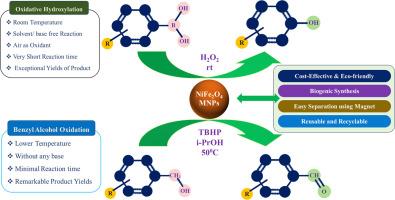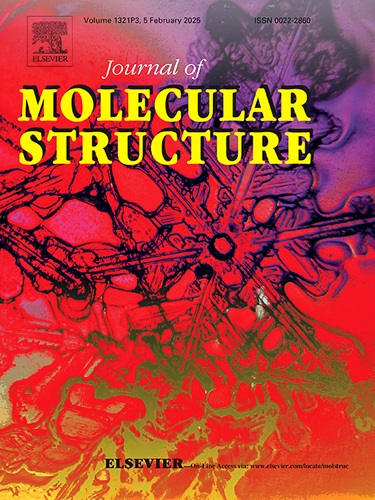无模板二氧化钛纳米颗粒的绿色合成:高效苯甲醛和酚醛基序的一种有前途的可持续催化剂
IF 4
2区 化学
Q2 CHEMISTRY, PHYSICAL
引用次数: 0
摘要
本研究介绍了一种经济、环保的利用山茶叶生物合成磁性纳米粒子NiFe2O4的方法。通过SEM-EDX、VSM、PXRD、XPS和TEM分析,对合成的纳米颗粒进行了全面表征,以详细了解其性能。TEM研究揭示了球形NiFe2O4磁性纳米颗粒的形成,而VSM分析揭示了它们的铁磁性行为。在室温下,它们在很短的时间内不使用任何溶剂/碱,对芳基硼酸的ipso羟基化表现出出色的催化性能。值得注意的是,在无碱和温和的反应条件下,多种苯甲醇转化为相应的醛,显示了合成纳米颗粒的多功能性和有效性。这些纳米颗粒可以很容易地用磁铁分离,并在两个反应中保持其催化活性长达五次,具有潜在的工业应用的显著经济优势。本文章由计算机程序翻译,如有差异,请以英文原文为准。

Green synthesis of template-free NiFe2O4 nanoparticles: A promising sustainable catalyst for efficient benzaldehyde and phenolic motifs development
This study introduces cost-effective and eco-friendly approach utilizing Camellia sinensis var. Assamica leaves for biogenic synthesis of NiFe2O4 magnetic nanoparticles. The synthesized nanoparticles underwent comprehensive characterization employing SEM-EDX, VSM, PXRD, XPS and TEM analyses to provide detailed insights into their properties. TEM investigations unveiled the formation of spherical NiFe2O4 magnetic nanoparticles, while VSM analysis revealed their ferromagnetic behavior. They demonstrate outstanding catalytic performance in the ipso-hydroxylation of arylboronic acids within very short amount of time without using any solvent/ base at room temperature. Remarkably, under base-free and mild reaction conditions, a diverse range of benzyl alcohols exhibited conversion to their corresponding aldehydes, showcasing the versatility and efficacy of as-synthesized nanoparticles. These nanoparticles could be readily separated using magnet and maintain their catalytic activity consistently for upto fifth run in both reactions, presenting significant economic advantages for potential industrial applications.
求助全文
通过发布文献求助,成功后即可免费获取论文全文。
去求助
来源期刊

Journal of Molecular Structure
化学-物理化学
CiteScore
7.10
自引率
15.80%
发文量
2384
审稿时长
45 days
期刊介绍:
The Journal of Molecular Structure is dedicated to the publication of full-length articles and review papers, providing important new structural information on all types of chemical species including:
• Stable and unstable molecules in all types of environments (vapour, molecular beam, liquid, solution, liquid crystal, solid state, matrix-isolated, surface-absorbed etc.)
• Chemical intermediates
• Molecules in excited states
• Biological molecules
• Polymers.
The methods used may include any combination of spectroscopic and non-spectroscopic techniques, for example:
• Infrared spectroscopy (mid, far, near)
• Raman spectroscopy and non-linear Raman methods (CARS, etc.)
• Electronic absorption spectroscopy
• Optical rotatory dispersion and circular dichroism
• Fluorescence and phosphorescence techniques
• Electron spectroscopies (PES, XPS), EXAFS, etc.
• Microwave spectroscopy
• Electron diffraction
• NMR and ESR spectroscopies
• Mössbauer spectroscopy
• X-ray crystallography
• Charge Density Analyses
• Computational Studies (supplementing experimental methods)
We encourage publications combining theoretical and experimental approaches. The structural insights gained by the studies should be correlated with the properties, activity and/ or reactivity of the molecule under investigation and the relevance of this molecule and its implications should be discussed.
 求助内容:
求助内容: 应助结果提醒方式:
应助结果提醒方式:


